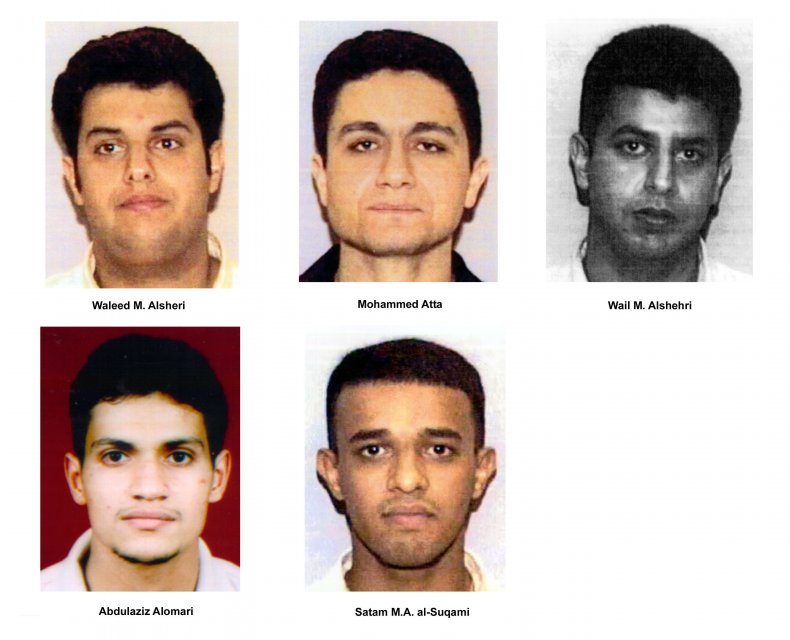WILLIAM M. ARKIN
Twenty years after the attacks of 9/11, there is still so much we do not know about that intensely studied day. The greatest void remains the hijackers—not the how of their diabolical plot, but the who: who they were as people.
That human element has been a taboo subject for two decades, as if trying to understand what they believed and what drove them would somehow justify or excuse their acts.
And yet their lives open up a door to perhaps one of the most intriguing mysteries of that terrible day: the South Tower of the World Trade Center was never a target that al Qaeda planned to hit. The implications are enormous: because of the decision of two of the hijacker pilots to hit both towers and die together, both buildings ultimately came down and the White House was spared.
In the course of my research into the terrorists' point of view, a source gave me access to thousands of pages of CIA interrogation transcripts and reports of captives who were involved in 9/11 plotting—most centrally Khalid Sheikh Mohammed (KSM), the mastermind of the plot who is now a prisoner at Guantanamo Bay.
 Hijackers Atta and al-Shehhi were roommates, and perhaps more. Undated photos of suspected hijackers of American Airlines flight #11. (L to R, top to bottom) Waleed M. Alshehri, Mohammed Atta, Wail M. Alshehri, Abdulaziz Alomari, and Satam M.A. al-Suqami.FBI/GETTY IMAGES
Hijackers Atta and al-Shehhi were roommates, and perhaps more. Undated photos of suspected hijackers of American Airlines flight #11. (L to R, top to bottom) Waleed M. Alshehri, Mohammed Atta, Wail M. Alshehri, Abdulaziz Alomari, and Satam M.A. al-Suqami.FBI/GETTY IMAGESOnly a very small group has ever had access to KSM's actual words, the records shielded by secrecy and buried in controversies over torture and black sites. And though what KSM had to say fed scores of breathless terror alerts and provided leads to uncover plotters and plots, the voluminous documentation largely went unexamined as a source to understand the lives and motivations of those who perpetrated 9/11.
In many interrogations and debriefings, KSM says that al Qaeda was looking for three classes of targets—military, political, and financial. Thus, in the mountains of Afghanistan, they chose the Pentagon, the White House, and the World Trade Center (as a financial center). Osama bin Laden, KSM says, added the U.S. Capitol building, believing that Congress was the source of America's unwavering support for Israel.
In thousands of pages, the CIA never reports KSM making mention of any plan to hit both towers. In fact, he says outright that he was surprised when both buildings were hit.
In that, KSM speculates that Mohammed Atta, the American-based leader of the plot and the pilot of American Airlines Flight 11 that hit the North Tower, and Marwan al-Shehhi, the hijacker who piloted United Airlines Flight 175 into the South Tower, did so because they wanted to die together. He repeatedly calls them unusually close and "different," using this to explain why they defied al Qaeda instructions. On more than one occasion, he calls them "homos," speculating that they might have been lovers.
In over a decade of reporting, I've asked many FBI and intelligence sources about the hypothesis that the South Tower was never what al Qaeda intended to attack, and all were surprised by the question, initially. But after reviewing the evidence, they don't dismiss the possibility—particularly not the FBI agents who were involved in reconstructing the lives of the 19 hijackers before 9/11.
After the attacks, over 100 agents and analysts pored over every move the pilots and "muscle men" made in the United States: everywhere they went, every meal they ate, every credit or debit card transaction, every phone call and email.
 Marwan al-Shehhi paid for flying time on August 8, 2001. On September 11, he hijacked United Airlines flight 175 and flew it into the South Tower of the World Trade Center.CNN VIA GETTY IMAGES
Marwan al-Shehhi paid for flying time on August 8, 2001. On September 11, he hijacked United Airlines flight 175 and flew it into the South Tower of the World Trade Center.CNN VIA GETTY IMAGESI've scoured that database as well. Over 15 months that they resided in the United States, Atta and al-Shehhi uniquely did everything together. They trained together, ate together, shopped together, and lived under the same roof. They spent nights together in hotels, including meeting in Boston just days before 9/11. They constantly checked in with each other by phone when they were separated, and al- Shehhi called Atta twice on the morning of September 11, the two separated by different terminals. They acted as a couple. None of the other pilots or muscle men fit any similar profile.
Ramzi bin al-Shibh (also a Guantanamo captive) and the Berlin-based operative who was Atta's link back to Afghanistan also reinforces this interpretation. He told U.S. interrogators that Atta and al-Shehhi had been best friends, roommates, and maybe even lovers for years, going back to their days in Hamburg where bin al-Shibh roomed with them in the same apartment. And he said that Atta was inconsolable when he was separated from al-Shehhi, constantly worrying about his young friend's wellbeing and health (al-Shehhi was ten years younger than Atta and may have also been gravely ill).
I've also contacted parents and friends of the 9/11 hijackers, many of whom were reluctant to talk and thus did so only on deep background, not wanting to have their lives further ruined by association with the events of that terrible day. Some of these people have even changed their names to disappear. Among them, there is almost universal agreement regarding some kind of special relationship between Atta and al-Shehhi. Members of Atta's family spoke to me of his psychological torment, embracing the hypothesis with their own homophobic slurs as a way of explaining the unexplainable: that somehow their lives—and their faith—had been perverted.
Perversion—that is, of the terrorists being "bad" Muslims—has always been a big part of the American narrative explaining the hijackers: that they spent their days watching porn and their nights slamming down drinks and visiting prostitutes; that they were evil hypocrites.
But in the entire FBI classified reconstruction of their actions in the U.S.—hundreds of pages and many thousands of entries—there is only one instance actually recorded of anything confirming this. On September 7, two of the musclemen who would fly on American Airlines Flight 11—Abdulaziz al-Omari and Satam al-Suqami—called the "Sweet Temptations" escort service from their Newton, Mass. motel and ordered two prostitutes. The women told the FBI that they had sex with the two, positively identifying them from ATM and visa photographs.
But there is no record of Atta and al-Shehhi doing anything similar, nor of any others of the 19 hijackers.
The story of Ziad Jarrah, the hijacker pilot of United Airlines Flight 193, adds further evidence.
Jarrah was headed for the U.S. Capitol but went down instead in Pennsylvania due to the heroic actions of the passengers. Married to a German woman of Turkish descent, during his time in America, living in Florida near Atta and al-Shehhi and spending most of his free time with the two men, he respectfully observed them. All during that time, Jarrah exchanged hundreds of emails and had countless phone calls with his wife in Germany, and he traveled to Germany five times to visit her.
Jarrah told her—and she told others—that much about America shook the views of the three, forcing them to ponder the difference between their societies and the richness and hope of the West. In America, no one pried into who they were. They were free to travel and practice their faith—and even train to be terrorists—without the mosque or secret police or even neighbors watching or judging. Atta and al-Shehhi, he said, were free to be themselves.
There is a final piece of the puzzle. A month before 9/11, we now know that there was a crucial phone call between Atta and bin al-Shibh, who was in Berlin. In that call, intercepted by German intelligence, the two explicitly discussed the targets. Donald Rumsfeld confirms this in his autobiography, that the two posed as students on the phone talking about different subjects of study. They talked about four targets, in code: "architecture" referred to the World Trade Center. "Arts" was the Pentagon. "Law" was the Capitol Building. "Politics" was the White House. No South Tower.
Why does Atta and al-Shehhi's relationship, or a possible change in targets, matter?
For one thing, it is now clear that attacks on both buildings were integral to their collapsing. The National Institute of Standards and Technology concluded that the resulting dispersal of fuel and debris, and the intense heat created, accumulated to cause both buildings to fall. Engineers who have studied the effect believe that had only one building been hit, it might have survived. Further evidence of the cumulative impact is seen in the nearby 7 World Trade Center, a building that wasn't directly attacked but also collapsed on 9/11 as a result of the cascading heat and flying debris. In other words, if things had gone according to al Qaeda's intended plan, the Trade Center complex might have survived, along with the 624 occupants of the South Tower and hundreds more who were below the 93rd floor of the North Tower, where the plane hit.
The most plausible explanation as to why both towers were struck—and the attacks synchronized so closely—was that Atta and al-Shehhi chose to die together.
Had the men followed al Qaeda's plan, the White House might also have been struck by UA Flight 175, piloted by al-Shehhi. Vice President Cheney, who was in the White House that morning, might have been killed.
Picture the White House, the ultimate American icon, destroyed. It's hard to imagine what the aftermath of such an attack would have been.
No comments:
Post a Comment